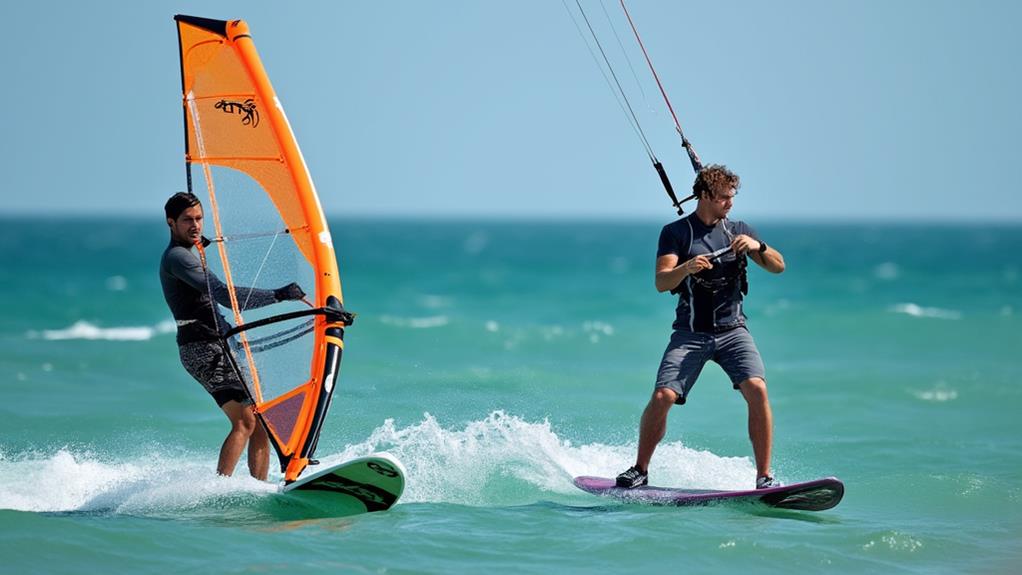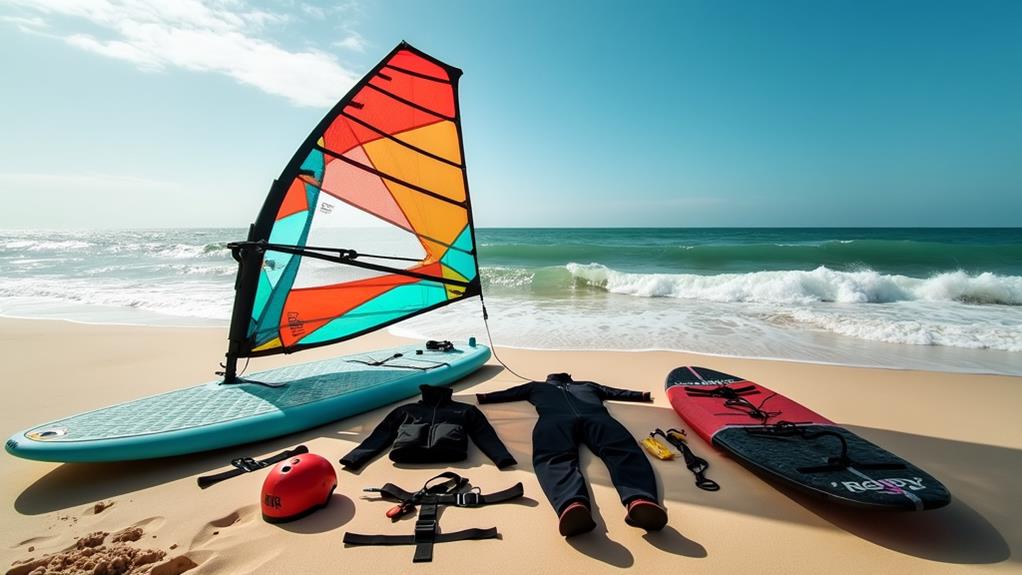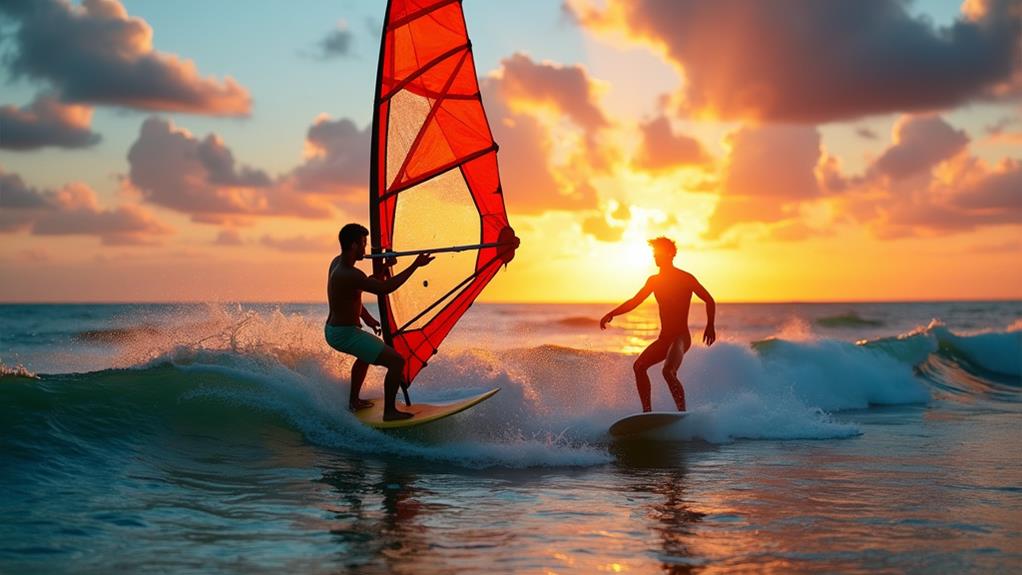How Risky Is Kite Surfing?
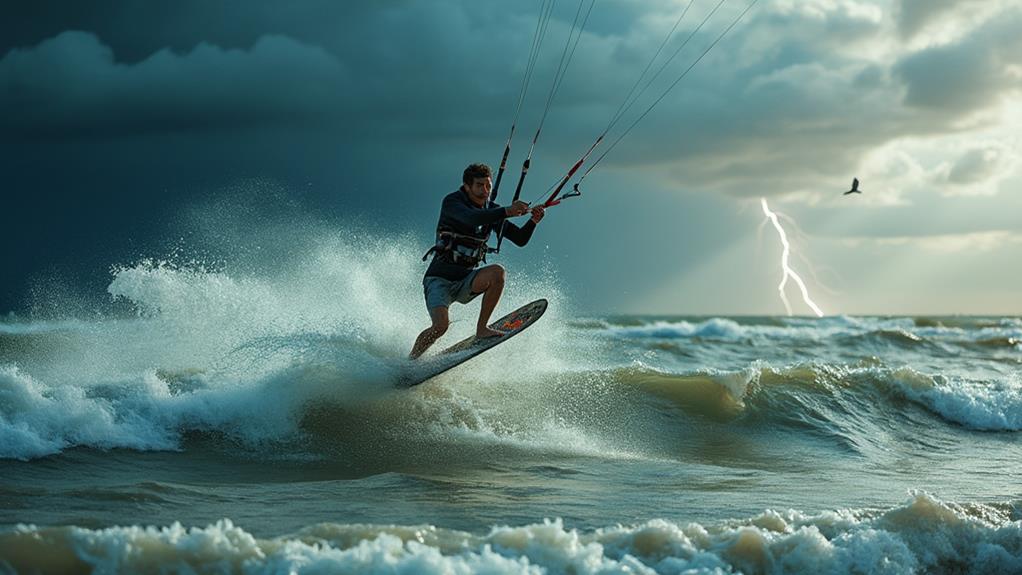
When you think about kite surfing, you might picture exhilarating rides over waves, but how risky is it really? With injury rates at approximately 10.5 per 1,000 hours of activity, and beginners being particularly vulnerable, it's vital to consider the full range of potential hazards. From equipment failures and adverse weather conditions to interactions with sea creatures, the risks are varied and significant. However, proper training, equipment maintenance, and awareness of local conditions can mitigate many of these dangers. So, what steps can you take to ensure a safer kite surfing experience?
Sea Creatures Hazards
When kitesurfing, be aware of various sea creature hazards. Jellyfish can cause severe stings and irritation; some species have venom that requires immediate medical attention. Sea urchins also pose a risk with their sharp spines, which can cause painful puncture wounds and potential infections. Always watch your step, especially in shallow waters.
While shark attacks are rare during kitesurfing, they are still a risk, especially if you are stranded or injured in the water. Avoid areas known for high shark activity and stay alert. In tropical regions, crocodiles can be a significant hazard. Make sure to gather local knowledge and perform a thorough risk assessment before entering the water.
Collisions with larger sea creatures like whales and dugongs, while uncommon, can be dangerous. If you spot a large marine animal, take evasive action to avoid a collision. Staying vigilant ensures your safety.
Wind and Weather Conditions
Understanding the dangers posed by sea creatures is vital, but equally important is being aware of wind and weather conditions when kitesurfing. Wind speed and weather conditions play a critical role in your safety on the water. Sudden wind changes can overpower you, leading to potentially dangerous situations if you're not prepared. Therefore, monitoring wind forecasts is essential.
Strong winds increase the risk of lofting, where the kite lifts you unexpectedly, causing serious injuries. If you're a beginner, it's advisable to practice in winds below 20 mph to maintain better kite control. Always land your kite before wind speeds increase significantly; losing control in gusty conditions can lead to accidents.
Avoid kiting in areas with unpredictable wind forecasts and familiarize yourself with local weather patterns. This knowledge will help you make safer decisions. On the beach, keep your kite low during strong winds and be prepared to deploy your safety system quickly to mitigate risks. Your safety system is crucial, allowing you to release the kite in emergencies. By staying vigilant about wind speed and weather conditions, you greatly enhance your kitesurfing safety.
Physical Stressors
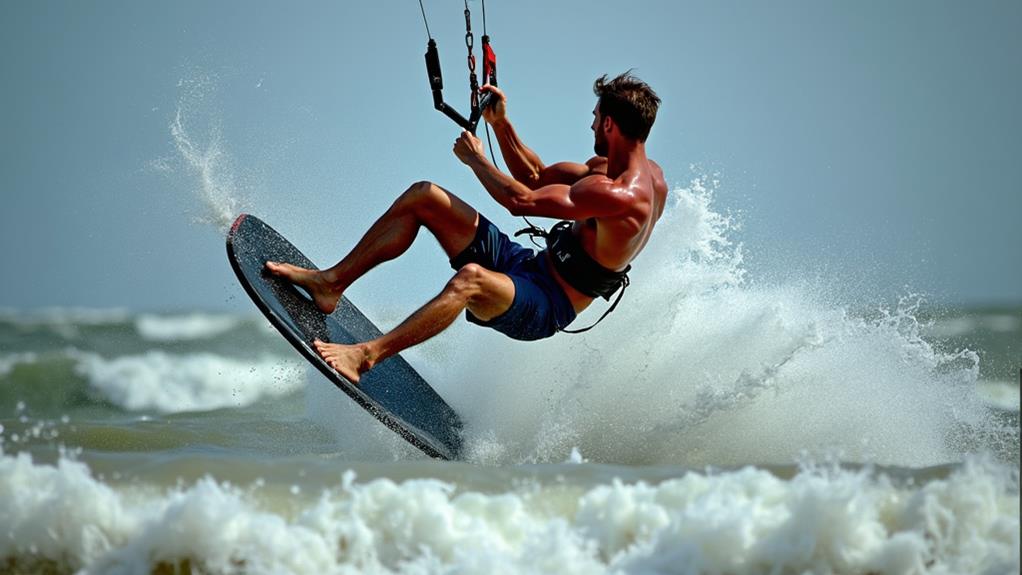
When kitesurfing, it's essential to protect yourself from sunburn with appropriate clothing and sunscreen. Additionally, managing fatigue levels is crucial to avoid overexertion and mistakes. Monitoring your physical condition ensures you stay safe and enjoy the sport longer.
Sunburn Prevention Tips
Prolonged sun exposure while kitesurfing can quickly lead to sunburn, making skin protection essential. To safeguard your skin, always use a broad-spectrum sunscreen with an SPF of 30 or higher. Apply it generously before heading out and reapply every two hours or immediately after getting wet. This crucial step ensures effective sun protection.
Wearing protective clothing, such as rash guards or wetsuits, provides an additional layer of defense against harmful UV rays. These garments not only shield your skin but also offer insulation, which is beneficial during water sports. Staying well-hydrated is equally important, as it helps maintain your skin's health and resilience against sun exposure.
To further minimize the risk of sunburn, plan your kitesurfing sessions outside the peak sun intensity hours of 10 a.m. to 4 p.m. This adjustment can significantly enhance your sun protection strategy.
Here's a quick reference table to keep your sunburn prevention measures in check:
| Sunburn Prevention Tip | Action | Benefit |
|---|---|---|
| Sunscreen | Apply SPF 30+ regularly | Effective skin protection |
| Protective Clothing | Wear rash guards or wetsuits | UV ray shielding and insulation |
| Hydration | Drink plenty of water | Maintains skin health |
| Timing | Surf before 10 a.m. or after 4 p.m. | Reduces sun exposure |
Managing Fatigue Levels
While sunburn prevention is crucial for a safe kitesurfing experience, managing fatigue is equally important. Fatigue can impair your judgment and control over the kite, increasing the risk of accidents. The excitement of kitesurfing often leads to overexertion, making it essential to know when to take breaks to maintain your energy levels.
Monitoring your energy throughout your session is vital. As fatigue sets in, the likelihood of mistakes increases, which can lead to injuries. Dehydration and poor nutrition exacerbate fatigue, so it's crucial to stay hydrated and well-nourished. A properly fueled body performs better and more safely.
To manage fatigue effectively:
- Stay hydrated: Drink water regularly to prevent dehydration.
- Pace yourself: Take frequent breaks and assess your physical state.
- Select appropriate conditions: Choose kitesurfing conditions that match your skill level to avoid overexertion.
Dangerous Practices
Kite surfing offers an exhilarating experience but comes with significant risks, particularly when engaging in hazardous practices. One notable danger is kite lines becoming tangled in offshore winds. If your kite crashes under these conditions, you risk being blown out to sea, and without strong swimming skills, drowning is a serious possibility. Always monitor wind direction and avoid offshore winds to mitigate this risk.
Jumping in shallow water is another perilous activity. The impact of landing can cause severe injuries, significantly increasing the injury rate among kitesurfers. Ensure that you only perform jumps in sufficiently deep water to cushion your landings.
Maintaining adequate downwind clearance is crucial. In crowded areas, collisions with other kiters or obstacles are common and often lead to injuries. Always ensure you have enough space downwind to avoid such accidents.
Lastly, always have a clear rescue or self-rescue plan. Quick decision-making can prevent life-threatening situations in the event of equipment failure or other emergencies. Being aware of wind conditions and having a solid rescue plan can significantly reduce the risks associated with kite surfing, ensuring that your experience remains safe and enjoyable.
Equipment Failures
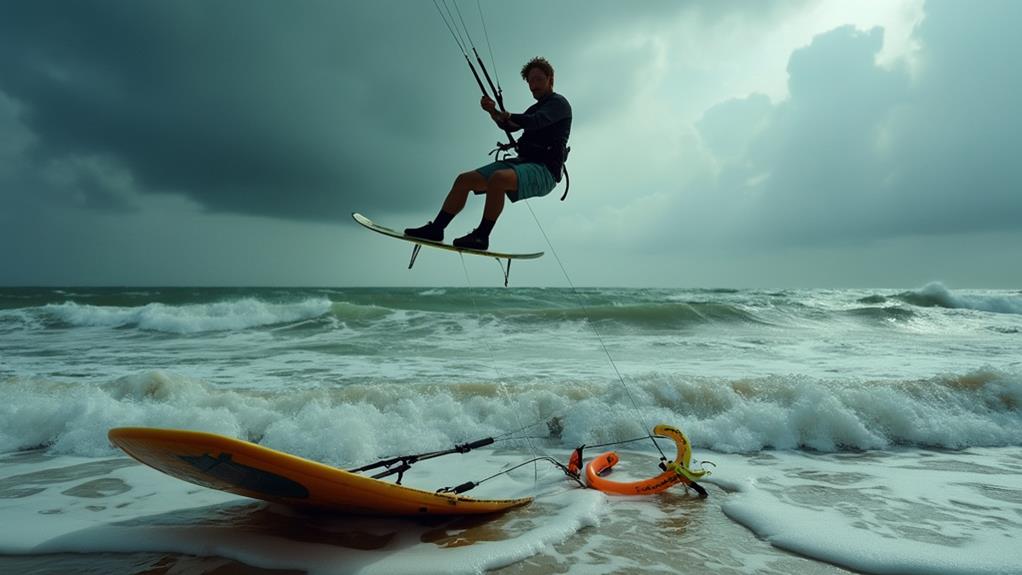
Equipment failures in kite surfing can pose serious hazards if not properly managed. Kite line failures, for instance, can lead to a sudden loss of control. To prevent this, it is crucial to regularly inspect and replace lines showing signs of wear or aging. Neglecting this can result in snapping lines, causing the kite to drop abruptly.
Kite bladder leaks also pose significant risks. Over time, the material can degrade, leading to malfunctions. These leaks can compromise the kite's performance, making routine checks and proper storage essential to avoid unexpected issues.
A harness malfunction can severely impact your stability and control. If your harness is old or poorly fitted, the chances of it failing increase. Regular fitting assessments are necessary to ensure that your harness remains secure and functional.
Here's a quick checklist to help you stay safe:
- Kite line inspections: Regularly check for wear and replace lines as needed.
- Kite bladder checks: Look for leaks and store your kite properly.
- Harness evaluations: Ensure your harness fits well and inspect it frequently.
Injury Statistics
Injury statistics highlight the risks associated with kitesurfing, revealing an injury rate of 10.5 per 1,000 hours of activity. Common injuries include cuts and abrasions (25.4%), contusions (19.8%), and joint sprains (17.5%). Most injuries occur in shallow water or during jumps, particularly while attempting tricks. Strong wind conditions, typically measured at 4-6 Beaufort, also contribute significantly to injury rates.
| Experience Level | Injury Rate (per 1,000 hours) |
|---|---|
| Beginners | 17.5 |
| 3-5 Years of Experience | 11.5 |
| All Kitesurfers | 10.5 |
| Injury Type | Percentage |
| Cuts and Abrasions | 25.4% |
| Contusions | 19.8% |
| Joint Sprains | 17.5% |
Interestingly, kitesurfers with 3-5 years of experience have a slightly higher injury rate (11.5 per 1,000 hours) compared to the general kitesurfing population. Beginners, however, face the highest injury rate at 17.5 per 1,000 hours. Monitoring wind conditions and avoiding shallow water can help mitigate these risks. Understanding these injury statistics can help you prepare and stay safe while enjoying kitesurfing.
Risk Management
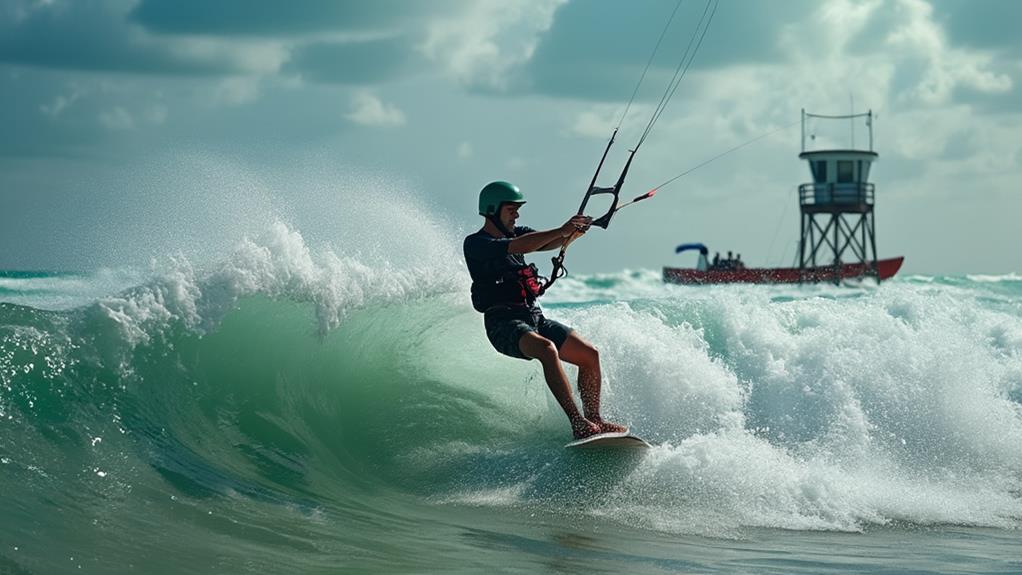
Effective risk management in kitesurfing begins with understanding and anticipating environmental factors. Over 90% of risks can be mitigated through knowledge and preparation. Familiarize yourself with local wind conditions, tides, and avoid kitesurfing during strong gusts or storms. Regular inspection and maintenance of your equipment are essential. Examine your kite lines for wear and ensure the kite bladder is intact to minimize the risk of equipment failure-related accidents.
Proper training is fundamental. Enroll in lessons from certified schools to acquire the skills and knowledge needed to navigate potential hazards. Always have a contingency plan for emergencies, such as equipment failure or getting caught in strong currents. Knowing how to quickly release your kite can be crucial for your safety.
Key points for managing risks:
- Inspect Your Gear: Regularly check kite lines and the kite bladder.
- Understand Wind: Familiarize yourself with local wind conditions and avoid strong gusts.
- Training: Obtain proper training from certified instructors.
Safety Improvements
Kitesurfing has become considerably safer in recent years due to advancements like push-away releases and standardized quick-release systems regulated by ISO 21853. Properly maintaining your gear and staying informed about best practices can further minimize the risk of injury. These improvements have led to a significant reduction in life-threatening incidents, making the sport safer for enthusiasts.
Enhanced Safety Systems
The introduction of standardized safety systems by leading kitesurfing brands has significantly enhanced the safety of the sport. The widespread adoption of push-away safety systems enables quick kite release in emergencies, a critical feature when encountering trouble in the water or strong winds.
However, the effectiveness of these safety systems depends on proper maintenance. Regularly inspecting your gear for wear and tear, especially the lines and bladders, ensures that your safety mechanisms function as intended.
Key advancements in safety systems include:
- Push-away safety systems: Facilitate rapid kite release during emergencies.
- ISO 21853 standard: Ensures uniformity and reliability of kite bar quick-release systems across the industry.
- Improved safety practices: Emphasize proper kite launching and line checks, crucial in both shallow water and on shore.
These developments collectively contribute to making kitesurfing a safer sport for enthusiasts.
Gear Maintenance Practices
Regularly inspecting your kitesurfing gear is crucial for ensuring your safety on the water. Proper gear maintenance helps prevent failures that could lead to accidents. Start by thoroughly examining your lines and pulleys to detect wear and tear early. Damaged components can lead to loss of control, increasing accident risks, particularly in shallow waters or during improper kite launches.
Always have a repair kit with patches for the canopy and bladder, as well as spare kite lines. Promptly addressing issues reduces downtime and enhances safety. The ocean's corrosive environment can damage even the most robust components, making routine maintenance essential. Look for rust and replace any corroded parts to ensure durability.
Modern safety systems, such as push-away safety releases, are essential for improving gear safety and reducing the risk of serious accidents due to equipment failure. Regularly test these systems to ensure they function correctly.


